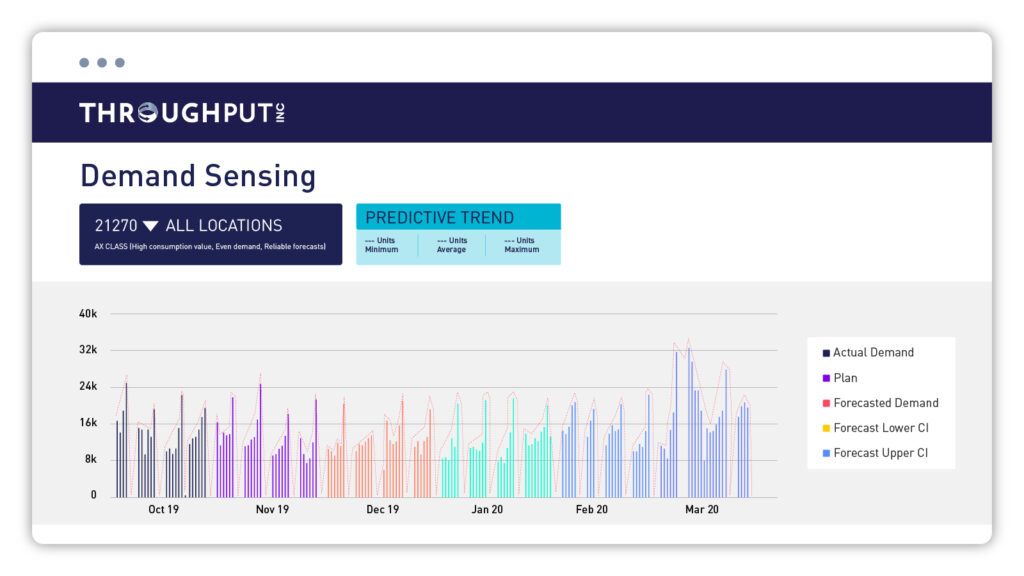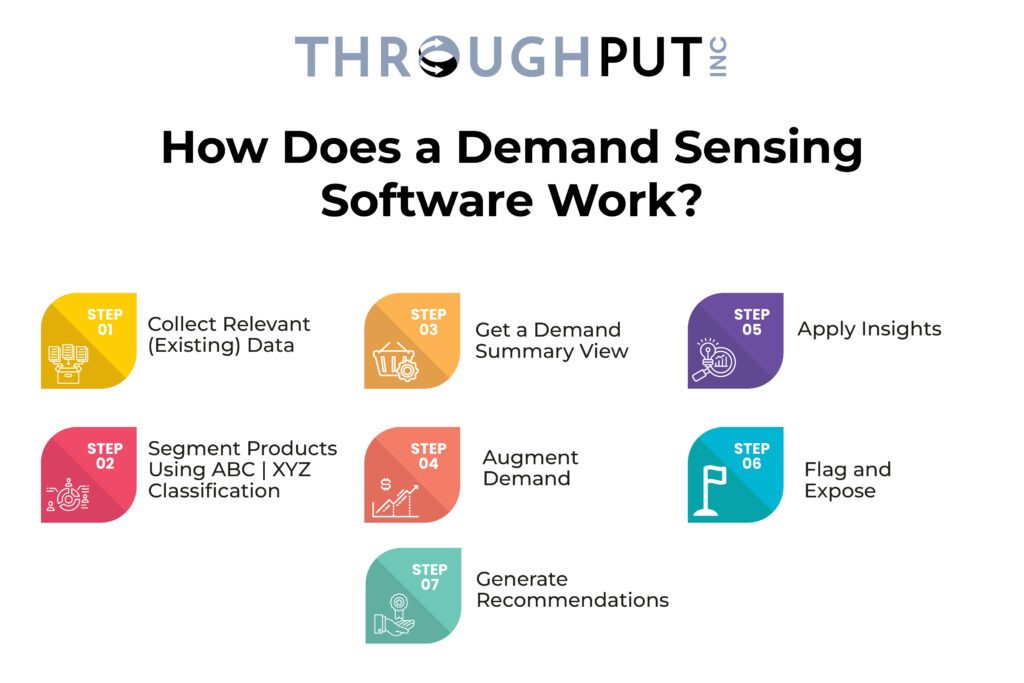Demand Sensing Software: Enhance Forecasting Accuracy with ThroughPut AI

Your daily responsibilities as a demand planner are anything but straightforward. Central to your role, you are tasked with predicting future demand patterns, a challenge that has grown increasingly complex. Inaccurate forecasts can lead to disruptions across the entire supply chain, impacting everything from material flows to cash flows.
These challenges are exacerbated by a reliance on traditional systems and spreadsheets, which often falter amid constant market disruptions and fluctuations in demand.
For example, while such systems are capable of analyzing demand, the process is typically slow and cumbersome. By the time the analysis is complete, external and internal variables may have shifted.
To navigate this ever-changing landscape, you require a tool that enables you to predict near-term demand and respond with agility. That tool is a demand sensing software.
Can a Good Demand Sensing Software Help?
Yes, a demand sensing software system powered by AI can be the optimal solution in this case.
It is important to understand at this point that demand sensing is not the same as demand forecasting.
Difference Between Demand Forecasting and Demand Sensing Software
- The Objective of the Software Systems
Demand forecasting utilizes historical data to predict demand on a long-term basis. This helps plan well and ahead for the future, be it labor, production, or inventory planning.
Demand sensing software, on the other hand, uses real-time data to predict short-term demand, enabling companies to respond faster to market changes.
- Forecast Durations
Demand forecasting software helps you with mid-term and long-term forecasts. The duration could range from a few months to a few years.
A demand sensing software will help you with forecasts that are more immediate, like days and even hours.
- Data Utilization
While the demand forecasting software depends on historical sales data, statistical models, and market research data, a demand sensing software uses data sources that generate real-time data. This includes sources like Point-of-Sale (POS), weather patterns, social media trends, and other information.
- Technological Approach
As mentioned earlier, demand forecasting depends on traditional statistical methods like time series analysis, while demand sensing uses new-age technologies like artificial intelligence and machine learning for accurate results.
- Granularity vs Aggregated Results
Demand forecasting offers aggregated results at higher levels. For example, product categories or region-wise demand forecasts. Demand sensing software, on the other hand, offers granular insights, for example, SKU-wise inventory details.
Features of a Good Demand Sensing Software

Feature #1: SKU-level Demand Insights
Demand varies significantly across different SKUs, making it essential for you to have precise and actionable insights SKU-wise. Effective demand sensing software provides these detailed, drilled-down insights at the SKU level. This capability enables you to identify low-value, low-demand SKUs while highlighting high-value, high-demand SKUs, ensuring they are prioritized to meet your customers’ needs and maximize profitability.
The demand insights capabilities offer ABC | XYZ segmentation of sellable products, month-over-month product mix and throughput rate tracking, top-performing/under-performing SKU highlights, and focus on main performing metrics (OTIF, OSA) per segment.
By drilling down into each SKU, the software enables you to make informed decisions, tailor your strategies, and respond swiftly to market changes.
With demand sensing software, you can also gain deep analytical insights in real-time using existing data to highlight key SKUs while maintaining a sharp focus on performance metrics.
Benefits
- Maximize customer service and experience while boosting overall revenue, higher margins, and increased profitability
- Reduce operational costs with accurate insights to make timely decisions
- Strengthen cross-functional collaboration between various stakeholders and teams like marketing, finance, planning, and sales for effective demand planning
Feature #2: Actionable Recommendations Based on Real-time Demand
In the supply chain domain, visibility is crucial but not quite enough. That’s because the entire domain is pretty complex. You need a tool that offers actionable insights.
For example, there is no dearth of tools in the market that lets you see how each SKU is performing, and that’s it. It does not tell you what to do next. It’s like you know exactly what’s happening but how to remedy it or enhance the situation – there’s no insight.
This is where advanced demand sensing software comes into the picture.
Take the case of ThroughPut AI. It doesn’t just offer you visibility but goes beyond to recommend what can be done to optimize supply chain management with accurate demand sensing. You get to understand the difference almost immediately.
For instance, the tool will suggest which SKUs should be discontinued, which ones need to be produced more, etc. It will also advise the precise quantities needed during peak seasons like festivals, weekends, etc.
The tool’s ability to transform data into decisive actions is what sets advanced demand sensing tools apart, enabling businesses to operate more efficiently and respond proactively to market dynamics.
Benefits
- Create and sustain customer-centric demand management mechanisms
- Regulate demand variability for new product and service introductions
- Optimize product mix and hit revenue goals
Feature #3: Analysis of Multiple Variables
Accurate forecasting is a complex task because demand is affected by multiple variables. Solely depending on historical data will not help in forecasting demand accurately. A good demand sensing software will take into account other factors like seasonality, and weather conditions to make accurate predictions. For example, winter clothing has higher demand during colder months or a sudden drop in temperature can push the demand for warm clothing.
Forecasting models used by trusted demand sensing software are programmed to include known future events, for example, a scheduled product launch. These events can lead to temporary dips or spikes in demand, and the same are, therefore, factored into forecasting models. Cyclical patterns like monthly and quarterly trends and seasonal shifts also help predict demand fluctuations. future planned events, promotions, holidays like Black Friday and Christmas, and cyclical and seasonal shifts. Business infrastructure-related changes like the store opening and closing schedules in specific locations are also considered.
Considering all these factors and multiple variables makes the demand sensing software more accurate in its demand forecasts.
Feature #4: Predictive Capabilities
Demand Sensing Software uses advanced analytics to provide accurate forecasts by loading and analyzing various data types. These capabilities include building in holidays, promotion schedules, price changes, and weather attributes to understand their impact on demand shifts.
By utilizing the exact correlation between these factors and demand fluctuations, you can gain valuable insights into consumer behaviors and mannerisms.
For instance, predictive models can reveal how a holiday promotion or a sudden weather change influences product demand, allowing you to adjust your strategies accordingly. This comprehensive approach ensures that demand predictions are not only accurate but also actionable, enabling you to optimize inventory levels, reduce stockouts, and enhance overall supply chain efficiency.
Use the demand sensing software to create accurate forecasts to plan raw material retention, manufacturing, allocation of resources, revise costing, and expedite fulfillment.
The predictive capabilities help compare realized demands with predictive trends. The accuracy improves as more data is factored into the forecast generation. The use of a predictive trend graph helps compare the actual demand, forecasted demand, and the plan, over a period.
Benefits
- Build on demand trends & accurate forecasting capabilities
- Analyze precise demand trends
- Monitor OTIF/OSA trends and prioritize improvement efforts based on impact on Sales/Throughput
How Does a Demand Sensing Software Work?
The best demand sensing software follows a seven-step approach to function effectively.

Step 1: Collect Relevant (Existing) Data
Gathering relevant data is the foundation of demand sensing software. Data sources include historical sales data, customer orders, point-of-sale (POS) data, market trends, weather information, and other external factors. Integrating these diverse data sources creates a comprehensive dataset that forms the basis for accurate predictions.
Often, businesses believe they don’t have enough existing data to work with. That’s far from the truth. The right tool can work with your existing data to get faster results.
Step 2: Segment Products Using ABC | XYZ Classification
The data is analyzed to categorize products based on demand predictability or reliability and their volume or consumption. The ABC classification divides products into categories based on their value or contribution to the business.
“A” items are high-value products that contribute the most to revenue, “B” items are moderately valuable, and “C” items are lower in value.
The XYZ classification categorizes products based on their demand predictability, reliability, volume, or consumption. “X” items have the most stable and predictable demand, “Y” items have moderate predictability, and “Z” items have the least predictable demand.
This level of product segmentation gives both a high-level perspective, allowing the identification of broad trends and patterns across product categories, and a granular view that focuses on specific data and characteristics for each product.
Step 3: Get a Demand Summary View
The demand summary view consolidates crucial metrics into a single snapshot, clearly understanding how effectively the supply chain is currently operating to meet customer demand for each product.
By monitoring Actual Throughput, Lost Throughput, On-time In-full (OTIF), and On Shelf Availability (OSA) performance, you can identify areas for improvement, optimize inventory management, enhance customer satisfaction, and drive more efficient supply chain operations.
Step 4: Augment Demand
Demand augmentation involves enhancing demand forecasting accuracy by incorporating additional factors or variables, known as regressors, that may impact customer demand. These factors could include holidays, promotional events, weather conditions, economic indicators, and other external influences.
By augmenting demand forecasting models with additional regressors, you can capture the influence of external factors that might otherwise be overlooked in traditional forecasting.
This approach enhances the accuracy of predictions, making them more reflective of real-world demand patterns and enabling better supply chain planning and decision-making.
Step 5: Apply Insights
In this step, extract insights from cyclical or seasonal trends and past regression effects on demand, and incorporate these insights into the demand forecast.
For instance, if the system identifies a consistent increase in demand during holiday seasons, use this knowledge to adjust the forecasted demand during upcoming holidays.
An advanced AI system designed to uncover hidden patterns and relationships in data at this step is used by ThroughPut AI. It goes beyond predicting outcomes and focuses on explaining the underlying factors contributing to those outcomes.
Step 6: Flag and Expose
This step entails analyzing data to recognize patterns where certain events or conditions consistently coincide with shifts in demand. When these correlations are identified, they are highlighted for further investigation and analysis.
Quantifying the strength and significance of these correlations helps understand their impact on demand. Insights derived from these relationships can inform decision-making, allowing you to anticipate demand fluctuations and adjust your strategies accordingly.
By incorporating these correlations into scenario simulations, you can explore how changes in specific factors might influence future demand. Monitoring and updating these correlations ensures supply chain operations and strategies remain aligned with dynamic market conditions.
However, it’s important to note that while correlations suggest a relationship, they don’t necessarily imply causation and careful analysis is needed to draw meaningful conclusions.
Step 7: Generate Recommendations
Once the demand forecast is established, the next step is to derive recommended inventory levels and operational plans. The planning involves aligning inventory quantities with the predicted demand, ensuring that products are available when customers want them.
Optimal inventory levels mean you can balance avoiding stockouts and minimizing excess inventory, leading to improved service levels.
Moreover, the recommended operations plans consider the predicted demand, ensuring that production schedules, procurement strategies, and other operational activities are synchronized with market requirements.
The alignment helps you optimize working capital by preventing overstocking or understocking situations. It also controls operational expenses by streamlining resource allocation and supply chain operations based on real-time and forecasted demand patterns.
The whole process enhances customer satisfaction through better product availability, supports efficient resource utilization, and fosters prudent financial management.
Benefits of ThroughPut AI’s Demand Sensing Module
ThroughPut AI’s Intelligent Demand Sensing Solution gives a competitive head-start to your demand planning tasks. There are various ways ThroughPut AI as a demand sensing software solution can assist you and that too strategically.
The software can transform raw sales data into operational insights at unmatched speed and scale. It has been designed and purpose-built for Operations and SCM professionals. Demand sensing benefits like streamlining operations across end-to-end SCM for better collaboration and higher productivity are achieved seamlessly.
ThroughPut’s ease of integration and implementation offers faster time to value and ROI. It helps link sales performance and lost opportunities with realistic operations and supply chain capability assessment. The tool has powerful reporting capabilities that will also help with timely decisions for demand excellence.
Book a free demo to get a clearer picture of demand sensing with ThroughPut AI.

